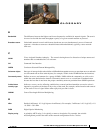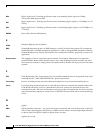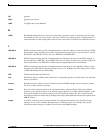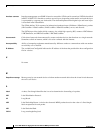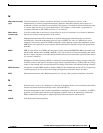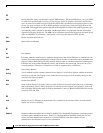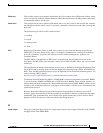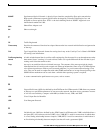
Glossary
GL-7
Cisco ASR 1000 Series Aggregation Services Routers MIB Specifications Guide
OL-15161-06
Read-only
This variable can be used to monitor information only. For example, the locIPUnreach variable, whose
access is read-only, indicates whether Internet Control Message Protocol (ICMP) packets concerning
an unreachable address will be sent.
Read-write
This variable can be used to monitor information and to set a new value for the variable. For example,
the tsMsgSend variable, whose access is read-write, determines what action to take after a message has
been sent.
The possible integer values for this variable follow:
1 = nothing
2 = reload
3 = message done
4 = abort
RFC
Requests for Comments, started in 1969, form a series of notes about the Internet (originally the
ARPANET). The notes discuss many aspects of computer communication, focusing on networking
protocols, procedures, programs, and concepts, but also include meeting notes, opinions, and
sometimes humor.
The RFC Editor is the publisher of RFCs and is responsible for the final editorial review of the
documents. The RFC Editor also maintains a master file of RFCs, the RFC index, that you can search
online here.
The specification documents of the Internet protocol suite, as defined by the Internet Engineering Task
Force (IETF) and its steering group, the Internet Engineering Steering Group (IESG), are published as
RFCs. Thus, the RFC publication process plays an important role in the Internet standards process. Go
to the following URL for details:
http://www.cisco.com/en/US/docs/ios/11_0/mib/quick/reference/mtext.html
RMON
The Remote Network Monitoring MIB is a SNMP MIB for remote management of networks. RMON
is one of the many SNMP based MIBs that are IETF Standards. RMON allows network operators to
monitor the health of the network with a Network Management System (NMS). RMON watches several
variables, such as Ethernet collisions, and triggers an event when a variable crosses a threshold in the
specified time interval.
RSVP
Resource Reservation Protocol. Protocol that supports the reservation of resources across an IP
network. Applications running on IP end systems can use RSVP to indicate to other nodes the nature
(bandwidth, jitter, maximum burst, and so forth) of the packet streams they want to receive. RSVP
depends on IPv4. Also known as Resource Reservation Setup Protocol.
S
Scalar object
One type of managed object which is a single object instance (for example, ifNumber in the IF-MIB
and bgpVersion in the BGP4-MIB).



